Understanding Professional Management and Leadership in HSC Context
VerifiedAdded on 2020/06/04
|13
|3814
|168
Report
AI Summary
This report delves into the realm of professional management and leadership within the context of health and social care, specifically using the National Health Service (NHS) as a case study. The report begins by outlining key leadership and management theories such as Scientific Theory, Human Relation Theory, Contingency Theory, and Systems Theory, and then explores how these theories can be applied to various situations within healthcare settings, such as partnership working and motivating teams. The influence of organizational values and culture on the application of these theories is also discussed. The report further examines the interdependencies between leadership and management, highlighting their similarities and differences. It analyzes potential conflicts arising from the application of different management and leadership models, and suggests strategies for conflict resolution. The skills of effective leaders and managers are detailed, emphasizing the importance of leadership and management skills in health and social care. The report concludes by explaining how leadership styles need to be adapted to manage different situations and how leadership skills can impact an organization's values. This report provides a comprehensive overview of the topic, offering insights into the practical application of leadership and management principles in the healthcare industry.
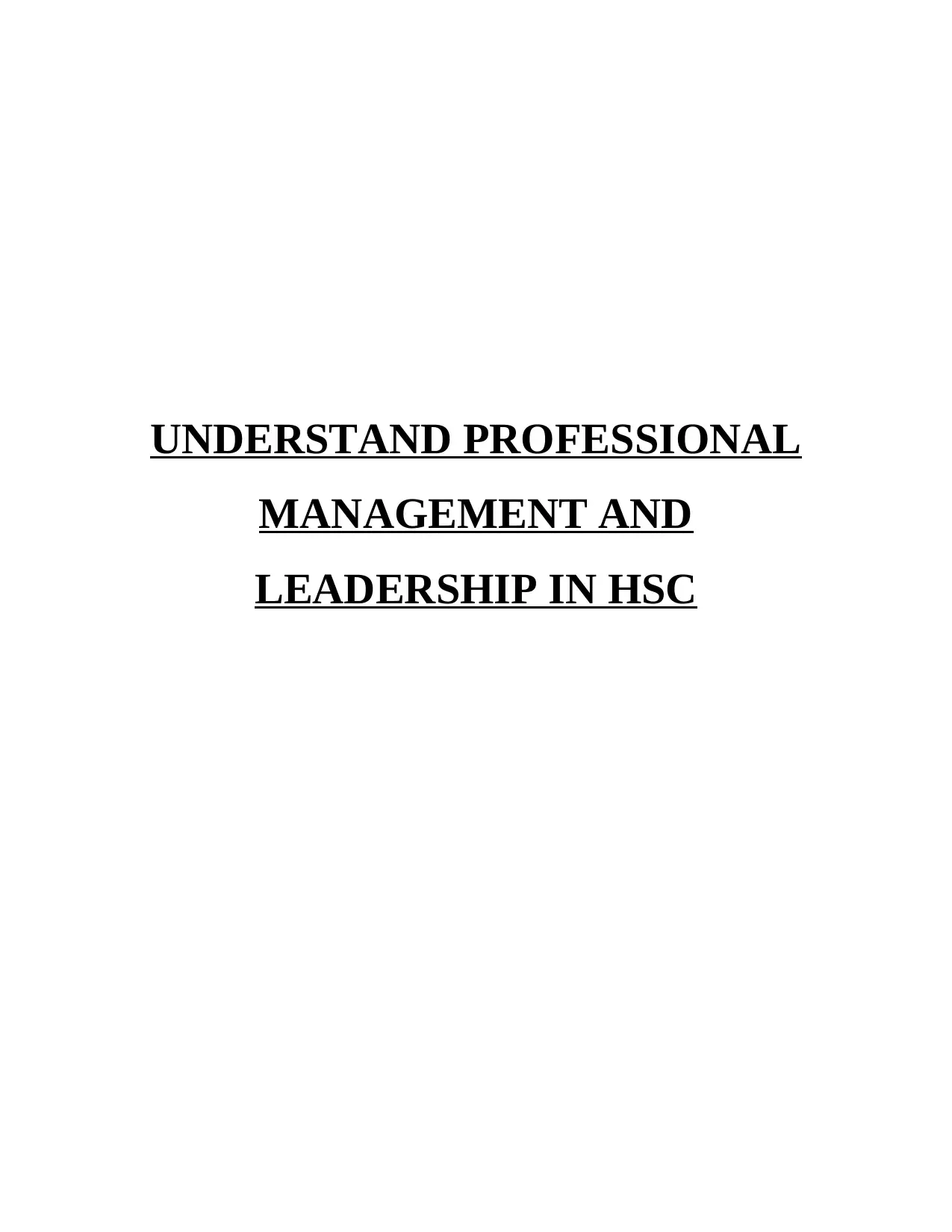
UNDERSTAND PROFESSIONAL
MANAGEMENT AND
LEADERSHIP IN HSC
MANAGEMENT AND
LEADERSHIP IN HSC
Paraphrase This Document
Need a fresh take? Get an instant paraphrase of this document with our AI Paraphraser
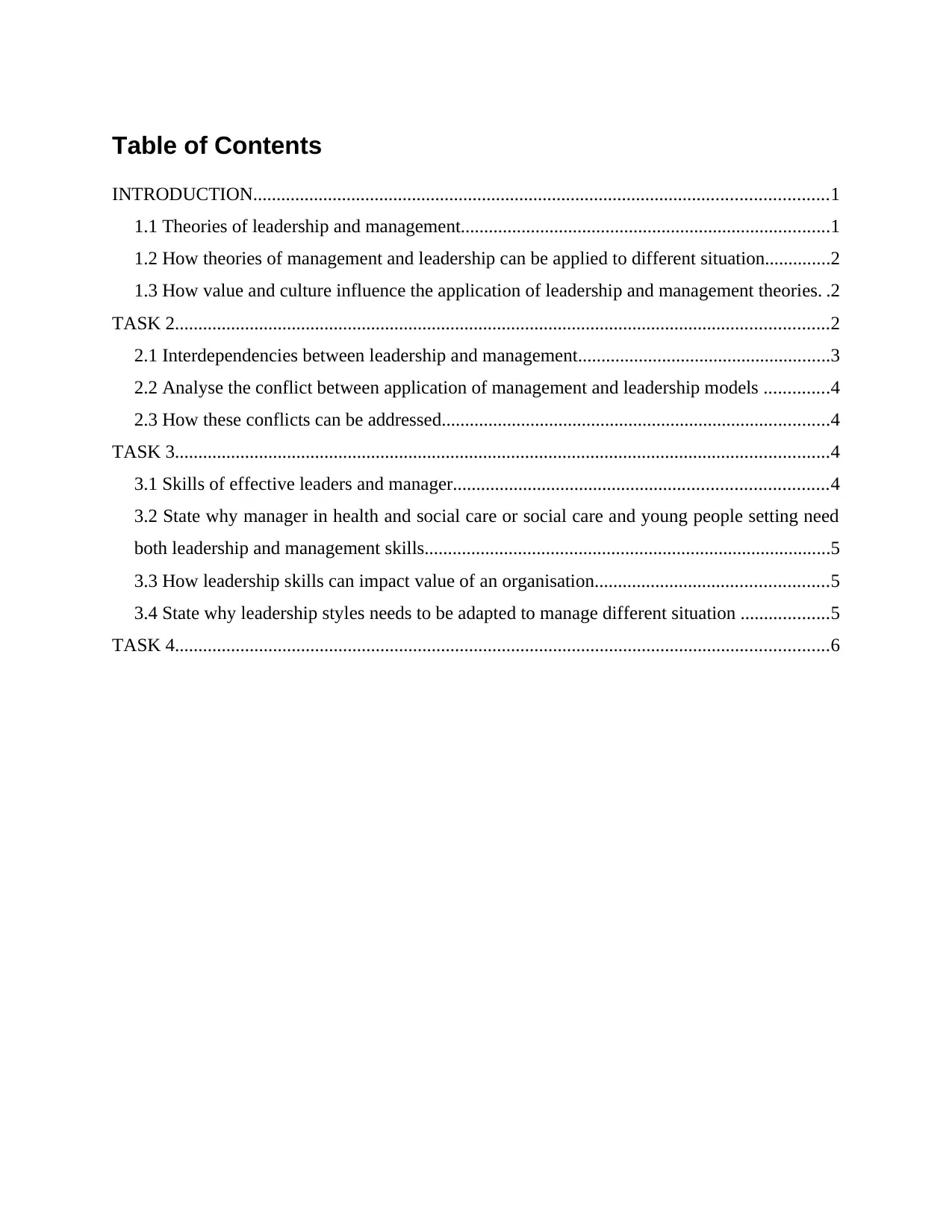
Table of Contents
INTRODUCTION...........................................................................................................................1
1.1 Theories of leadership and management...............................................................................1
1.2 How theories of management and leadership can be applied to different situation..............2
1.3 How value and culture influence the application of leadership and management theories. .2
TASK 2............................................................................................................................................2
2.1 Interdependencies between leadership and management......................................................3
2.2 Analyse the conflict between application of management and leadership models ..............4
2.3 How these conflicts can be addressed...................................................................................4
TASK 3............................................................................................................................................4
3.1 Skills of effective leaders and manager................................................................................4
3.2 State why manager in health and social care or social care and young people setting need
both leadership and management skills.......................................................................................5
3.3 How leadership skills can impact value of an organisation..................................................5
3.4 State why leadership styles needs to be adapted to manage different situation ...................5
TASK 4............................................................................................................................................6
INTRODUCTION...........................................................................................................................1
1.1 Theories of leadership and management...............................................................................1
1.2 How theories of management and leadership can be applied to different situation..............2
1.3 How value and culture influence the application of leadership and management theories. .2
TASK 2............................................................................................................................................2
2.1 Interdependencies between leadership and management......................................................3
2.2 Analyse the conflict between application of management and leadership models ..............4
2.3 How these conflicts can be addressed...................................................................................4
TASK 3............................................................................................................................................4
3.1 Skills of effective leaders and manager................................................................................4
3.2 State why manager in health and social care or social care and young people setting need
both leadership and management skills.......................................................................................5
3.3 How leadership skills can impact value of an organisation..................................................5
3.4 State why leadership styles needs to be adapted to manage different situation ...................5
TASK 4............................................................................................................................................6
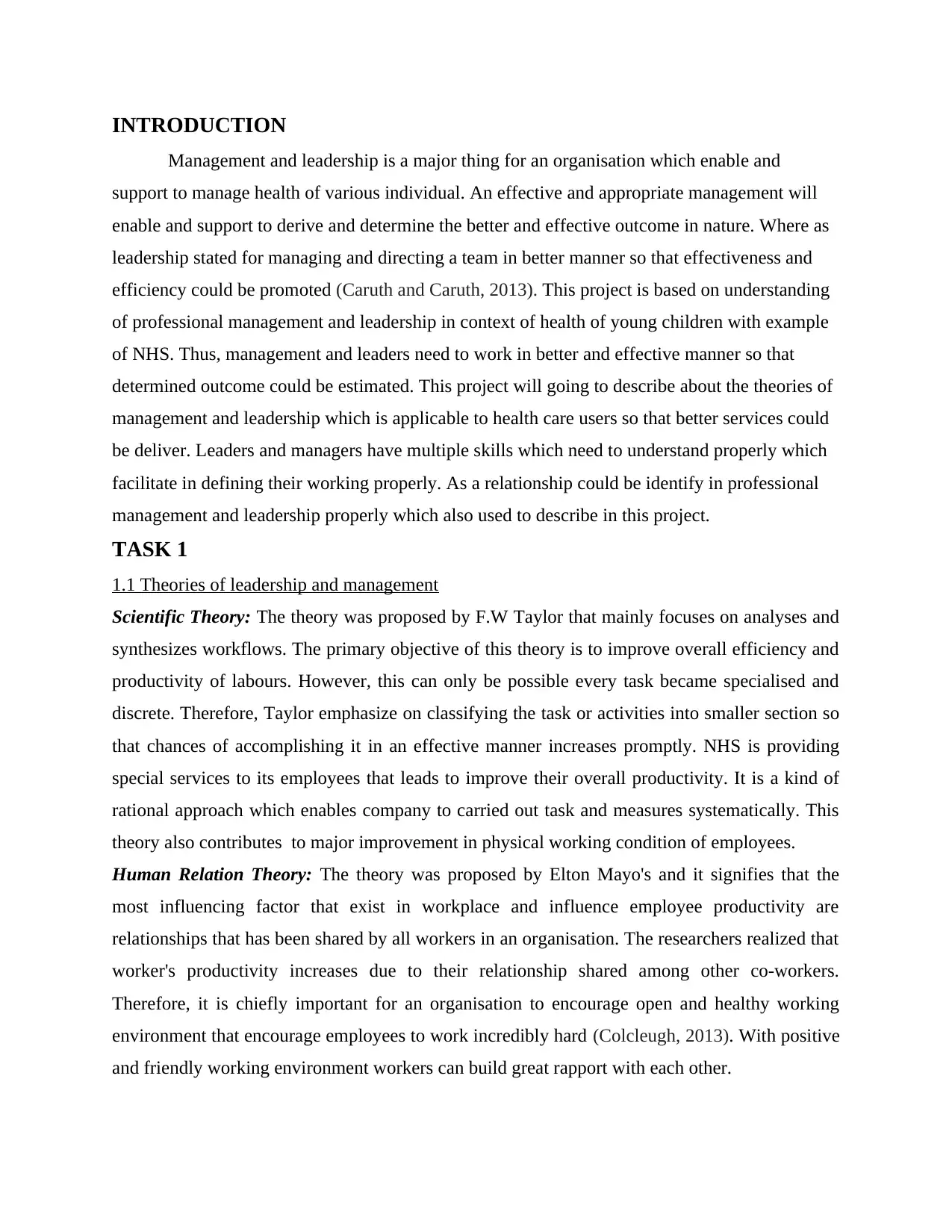
INTRODUCTION
Management and leadership is a major thing for an organisation which enable and
support to manage health of various individual. An effective and appropriate management will
enable and support to derive and determine the better and effective outcome in nature. Where as
leadership stated for managing and directing a team in better manner so that effectiveness and
efficiency could be promoted (Caruth and Caruth, 2013). This project is based on understanding
of professional management and leadership in context of health of young children with example
of NHS. Thus, management and leaders need to work in better and effective manner so that
determined outcome could be estimated. This project will going to describe about the theories of
management and leadership which is applicable to health care users so that better services could
be deliver. Leaders and managers have multiple skills which need to understand properly which
facilitate in defining their working properly. As a relationship could be identify in professional
management and leadership properly which also used to describe in this project.
TASK 1
1.1 Theories of leadership and management
Scientific Theory: The theory was proposed by F.W Taylor that mainly focuses on analyses and
synthesizes workflows. The primary objective of this theory is to improve overall efficiency and
productivity of labours. However, this can only be possible every task became specialised and
discrete. Therefore, Taylor emphasize on classifying the task or activities into smaller section so
that chances of accomplishing it in an effective manner increases promptly. NHS is providing
special services to its employees that leads to improve their overall productivity. It is a kind of
rational approach which enables company to carried out task and measures systematically. This
theory also contributes to major improvement in physical working condition of employees.
Human Relation Theory: The theory was proposed by Elton Mayo's and it signifies that the
most influencing factor that exist in workplace and influence employee productivity are
relationships that has been shared by all workers in an organisation. The researchers realized that
worker's productivity increases due to their relationship shared among other co-workers.
Therefore, it is chiefly important for an organisation to encourage open and healthy working
environment that encourage employees to work incredibly hard (Colcleugh, 2013). With positive
and friendly working environment workers can build great rapport with each other.
Management and leadership is a major thing for an organisation which enable and
support to manage health of various individual. An effective and appropriate management will
enable and support to derive and determine the better and effective outcome in nature. Where as
leadership stated for managing and directing a team in better manner so that effectiveness and
efficiency could be promoted (Caruth and Caruth, 2013). This project is based on understanding
of professional management and leadership in context of health of young children with example
of NHS. Thus, management and leaders need to work in better and effective manner so that
determined outcome could be estimated. This project will going to describe about the theories of
management and leadership which is applicable to health care users so that better services could
be deliver. Leaders and managers have multiple skills which need to understand properly which
facilitate in defining their working properly. As a relationship could be identify in professional
management and leadership properly which also used to describe in this project.
TASK 1
1.1 Theories of leadership and management
Scientific Theory: The theory was proposed by F.W Taylor that mainly focuses on analyses and
synthesizes workflows. The primary objective of this theory is to improve overall efficiency and
productivity of labours. However, this can only be possible every task became specialised and
discrete. Therefore, Taylor emphasize on classifying the task or activities into smaller section so
that chances of accomplishing it in an effective manner increases promptly. NHS is providing
special services to its employees that leads to improve their overall productivity. It is a kind of
rational approach which enables company to carried out task and measures systematically. This
theory also contributes to major improvement in physical working condition of employees.
Human Relation Theory: The theory was proposed by Elton Mayo's and it signifies that the
most influencing factor that exist in workplace and influence employee productivity are
relationships that has been shared by all workers in an organisation. The researchers realized that
worker's productivity increases due to their relationship shared among other co-workers.
Therefore, it is chiefly important for an organisation to encourage open and healthy working
environment that encourage employees to work incredibly hard (Colcleugh, 2013). With positive
and friendly working environment workers can build great rapport with each other.
⊘ This is a preview!⊘
Do you want full access?
Subscribe today to unlock all pages.

Trusted by 1+ million students worldwide
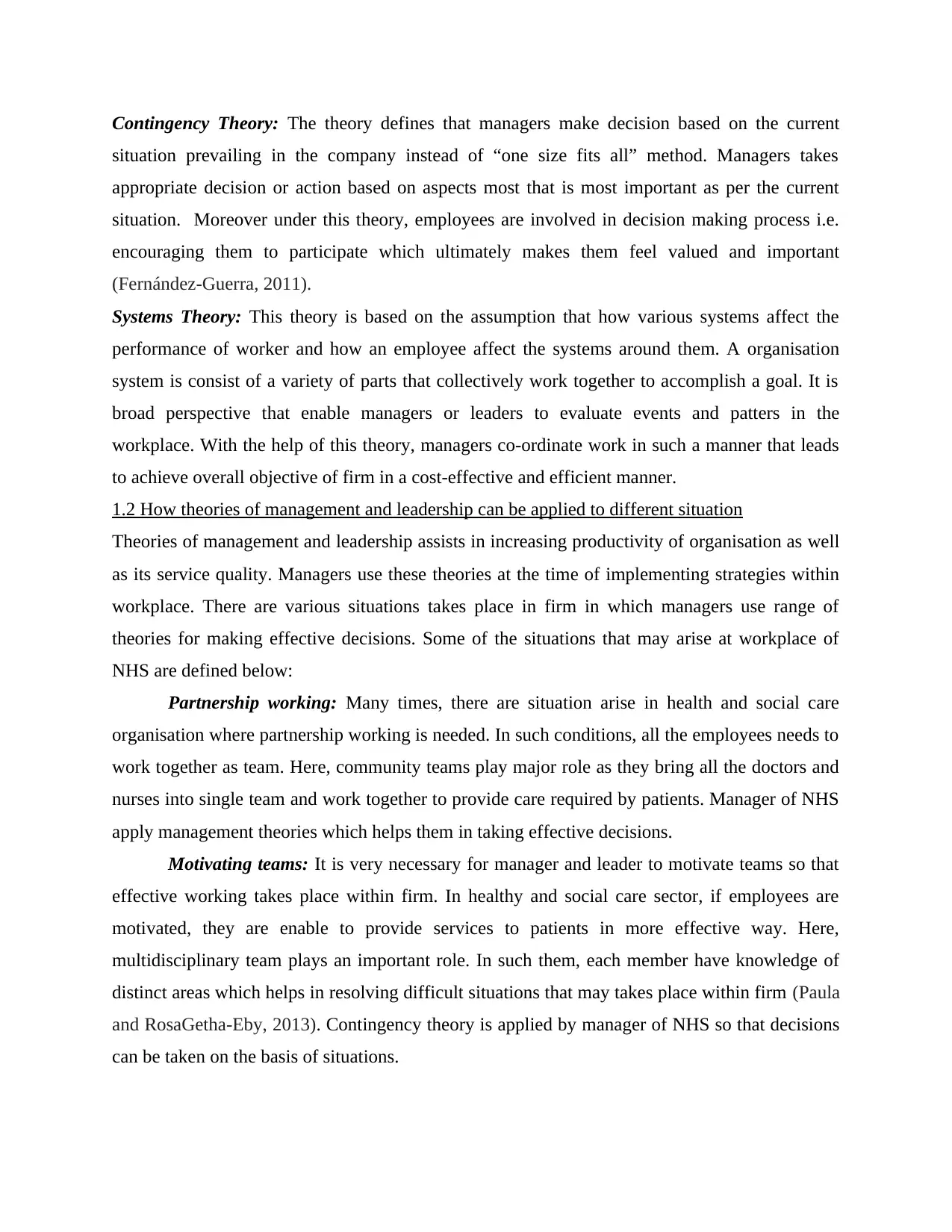
Contingency Theory: The theory defines that managers make decision based on the current
situation prevailing in the company instead of “one size fits all” method. Managers takes
appropriate decision or action based on aspects most that is most important as per the current
situation. Moreover under this theory, employees are involved in decision making process i.e.
encouraging them to participate which ultimately makes them feel valued and important
(Fernández-Guerra, 2011).
Systems Theory: This theory is based on the assumption that how various systems affect the
performance of worker and how an employee affect the systems around them. A organisation
system is consist of a variety of parts that collectively work together to accomplish a goal. It is
broad perspective that enable managers or leaders to evaluate events and patters in the
workplace. With the help of this theory, managers co-ordinate work in such a manner that leads
to achieve overall objective of firm in a cost-effective and efficient manner.
1.2 How theories of management and leadership can be applied to different situation
Theories of management and leadership assists in increasing productivity of organisation as well
as its service quality. Managers use these theories at the time of implementing strategies within
workplace. There are various situations takes place in firm in which managers use range of
theories for making effective decisions. Some of the situations that may arise at workplace of
NHS are defined below:
Partnership working: Many times, there are situation arise in health and social care
organisation where partnership working is needed. In such conditions, all the employees needs to
work together as team. Here, community teams play major role as they bring all the doctors and
nurses into single team and work together to provide care required by patients. Manager of NHS
apply management theories which helps them in taking effective decisions.
Motivating teams: It is very necessary for manager and leader to motivate teams so that
effective working takes place within firm. In healthy and social care sector, if employees are
motivated, they are enable to provide services to patients in more effective way. Here,
multidisciplinary team plays an important role. In such them, each member have knowledge of
distinct areas which helps in resolving difficult situations that may takes place within firm (Paula
and RosaGetha-Eby, 2013). Contingency theory is applied by manager of NHS so that decisions
can be taken on the basis of situations.
situation prevailing in the company instead of “one size fits all” method. Managers takes
appropriate decision or action based on aspects most that is most important as per the current
situation. Moreover under this theory, employees are involved in decision making process i.e.
encouraging them to participate which ultimately makes them feel valued and important
(Fernández-Guerra, 2011).
Systems Theory: This theory is based on the assumption that how various systems affect the
performance of worker and how an employee affect the systems around them. A organisation
system is consist of a variety of parts that collectively work together to accomplish a goal. It is
broad perspective that enable managers or leaders to evaluate events and patters in the
workplace. With the help of this theory, managers co-ordinate work in such a manner that leads
to achieve overall objective of firm in a cost-effective and efficient manner.
1.2 How theories of management and leadership can be applied to different situation
Theories of management and leadership assists in increasing productivity of organisation as well
as its service quality. Managers use these theories at the time of implementing strategies within
workplace. There are various situations takes place in firm in which managers use range of
theories for making effective decisions. Some of the situations that may arise at workplace of
NHS are defined below:
Partnership working: Many times, there are situation arise in health and social care
organisation where partnership working is needed. In such conditions, all the employees needs to
work together as team. Here, community teams play major role as they bring all the doctors and
nurses into single team and work together to provide care required by patients. Manager of NHS
apply management theories which helps them in taking effective decisions.
Motivating teams: It is very necessary for manager and leader to motivate teams so that
effective working takes place within firm. In healthy and social care sector, if employees are
motivated, they are enable to provide services to patients in more effective way. Here,
multidisciplinary team plays an important role. In such them, each member have knowledge of
distinct areas which helps in resolving difficult situations that may takes place within firm (Paula
and RosaGetha-Eby, 2013). Contingency theory is applied by manager of NHS so that decisions
can be taken on the basis of situations.
Paraphrase This Document
Need a fresh take? Get an instant paraphrase of this document with our AI Paraphraser
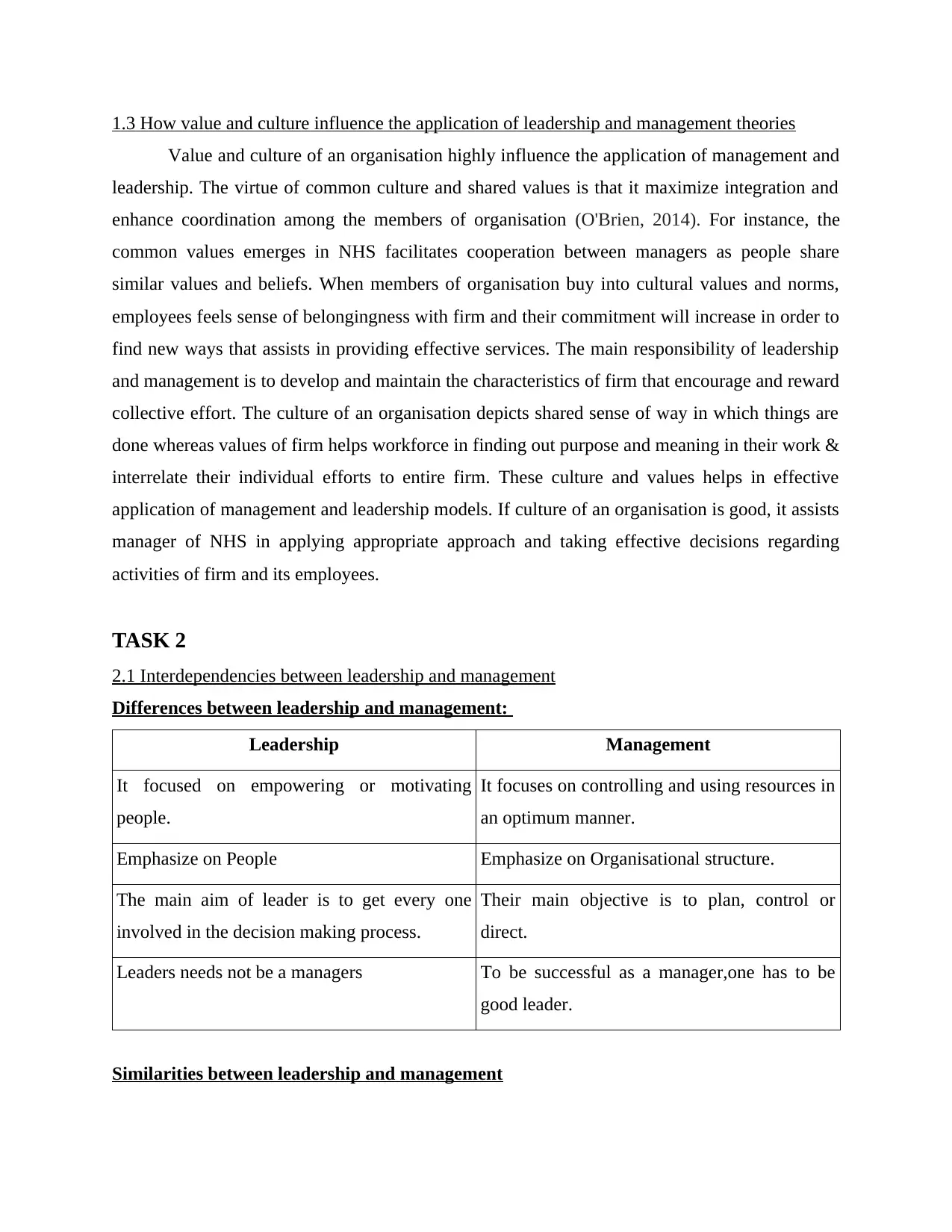
1.3 How value and culture influence the application of leadership and management theories
Value and culture of an organisation highly influence the application of management and
leadership. The virtue of common culture and shared values is that it maximize integration and
enhance coordination among the members of organisation (O'Brien, 2014). For instance, the
common values emerges in NHS facilitates cooperation between managers as people share
similar values and beliefs. When members of organisation buy into cultural values and norms,
employees feels sense of belongingness with firm and their commitment will increase in order to
find new ways that assists in providing effective services. The main responsibility of leadership
and management is to develop and maintain the characteristics of firm that encourage and reward
collective effort. The culture of an organisation depicts shared sense of way in which things are
done whereas values of firm helps workforce in finding out purpose and meaning in their work &
interrelate their individual efforts to entire firm. These culture and values helps in effective
application of management and leadership models. If culture of an organisation is good, it assists
manager of NHS in applying appropriate approach and taking effective decisions regarding
activities of firm and its employees.
TASK 2
2.1 Interdependencies between leadership and management
Differences between leadership and management:
Leadership Management
It focused on empowering or motivating
people.
It focuses on controlling and using resources in
an optimum manner.
Emphasize on People Emphasize on Organisational structure.
The main aim of leader is to get every one
involved in the decision making process.
Their main objective is to plan, control or
direct.
Leaders needs not be a managers To be successful as a manager,one has to be
good leader.
Similarities between leadership and management
Value and culture of an organisation highly influence the application of management and
leadership. The virtue of common culture and shared values is that it maximize integration and
enhance coordination among the members of organisation (O'Brien, 2014). For instance, the
common values emerges in NHS facilitates cooperation between managers as people share
similar values and beliefs. When members of organisation buy into cultural values and norms,
employees feels sense of belongingness with firm and their commitment will increase in order to
find new ways that assists in providing effective services. The main responsibility of leadership
and management is to develop and maintain the characteristics of firm that encourage and reward
collective effort. The culture of an organisation depicts shared sense of way in which things are
done whereas values of firm helps workforce in finding out purpose and meaning in their work &
interrelate their individual efforts to entire firm. These culture and values helps in effective
application of management and leadership models. If culture of an organisation is good, it assists
manager of NHS in applying appropriate approach and taking effective decisions regarding
activities of firm and its employees.
TASK 2
2.1 Interdependencies between leadership and management
Differences between leadership and management:
Leadership Management
It focused on empowering or motivating
people.
It focuses on controlling and using resources in
an optimum manner.
Emphasize on People Emphasize on Organisational structure.
The main aim of leader is to get every one
involved in the decision making process.
Their main objective is to plan, control or
direct.
Leaders needs not be a managers To be successful as a manager,one has to be
good leader.
Similarities between leadership and management

Management and leadership entail working with people: The primary objective of every
company is to yield higher profitability ratio and this can only be possible with the collective
efforts made by employees. Here managers and leaders plays crucial role in encouraging and
motivating workforce so that they can work incredibly hard (Grootenboer, Edwards-Groves and
Rönnerman, 2015). Also they aid in formulating such policies or strategies that provides
benefits to them in terms of higher incentives, flexible working condition.
Management and leadership involve influence: Both managers and leaders influence
employees. Leaders mostly influence them through their thoughts, ideas, communication skill
whereas Managers impact workers on the basis of their actions. Employee performance is
depend upon the manner in which they see their managers or leaders doing their respective task.
Management and leadership concerned with accomplishment of goal: Every organisation
aims at achieving business goals within stipulated time frame and this can only be possible if
employees collectively work together. If employees are motivated and satisfied with the work
environment prevailing in the company enables them to contribute more effectively towards
achieving business objectives.
Interlink between management and leadership
Both leaders and managers play key crucial role in organisational success and growth.
According to (Henry, 2017) leadership is an important part of effective management. As a main
component of management, the role of successful leader is to build an environment in which
each and every worker develops and excel. Also good manager needs to have some traits of
leaders that makes them more effective and efficient in their work. Therefore, it can be
concluded that both management and leadership are inter-linked with each other.
2.2 Analyse the conflict between application of management and leadership models
At certain times, it become difficult for employees to adapt changes embedded by leader
or managers. The policies made by company may not benefit or satisfies employees in the
manner in which they are thinking. There are certain times when management is dissatisfied
with leadership style adopted by NHS leaders which leads to create conflict among them.
Another reason that arise conflict between company's manager and leaders in due to ineffective
communication among them. Managers take decision or formulate policies without the
involvement of leaders (Lelmini and Fugazza, 2011). When managers frame policies without
leaders it become difficult for leaders to execute them in a manner in which management is
company is to yield higher profitability ratio and this can only be possible with the collective
efforts made by employees. Here managers and leaders plays crucial role in encouraging and
motivating workforce so that they can work incredibly hard (Grootenboer, Edwards-Groves and
Rönnerman, 2015). Also they aid in formulating such policies or strategies that provides
benefits to them in terms of higher incentives, flexible working condition.
Management and leadership involve influence: Both managers and leaders influence
employees. Leaders mostly influence them through their thoughts, ideas, communication skill
whereas Managers impact workers on the basis of their actions. Employee performance is
depend upon the manner in which they see their managers or leaders doing their respective task.
Management and leadership concerned with accomplishment of goal: Every organisation
aims at achieving business goals within stipulated time frame and this can only be possible if
employees collectively work together. If employees are motivated and satisfied with the work
environment prevailing in the company enables them to contribute more effectively towards
achieving business objectives.
Interlink between management and leadership
Both leaders and managers play key crucial role in organisational success and growth.
According to (Henry, 2017) leadership is an important part of effective management. As a main
component of management, the role of successful leader is to build an environment in which
each and every worker develops and excel. Also good manager needs to have some traits of
leaders that makes them more effective and efficient in their work. Therefore, it can be
concluded that both management and leadership are inter-linked with each other.
2.2 Analyse the conflict between application of management and leadership models
At certain times, it become difficult for employees to adapt changes embedded by leader
or managers. The policies made by company may not benefit or satisfies employees in the
manner in which they are thinking. There are certain times when management is dissatisfied
with leadership style adopted by NHS leaders which leads to create conflict among them.
Another reason that arise conflict between company's manager and leaders in due to ineffective
communication among them. Managers take decision or formulate policies without the
involvement of leaders (Lelmini and Fugazza, 2011). When managers frame policies without
leaders it become difficult for leaders to execute them in a manner in which management is
⊘ This is a preview!⊘
Do you want full access?
Subscribe today to unlock all pages.

Trusted by 1+ million students worldwide
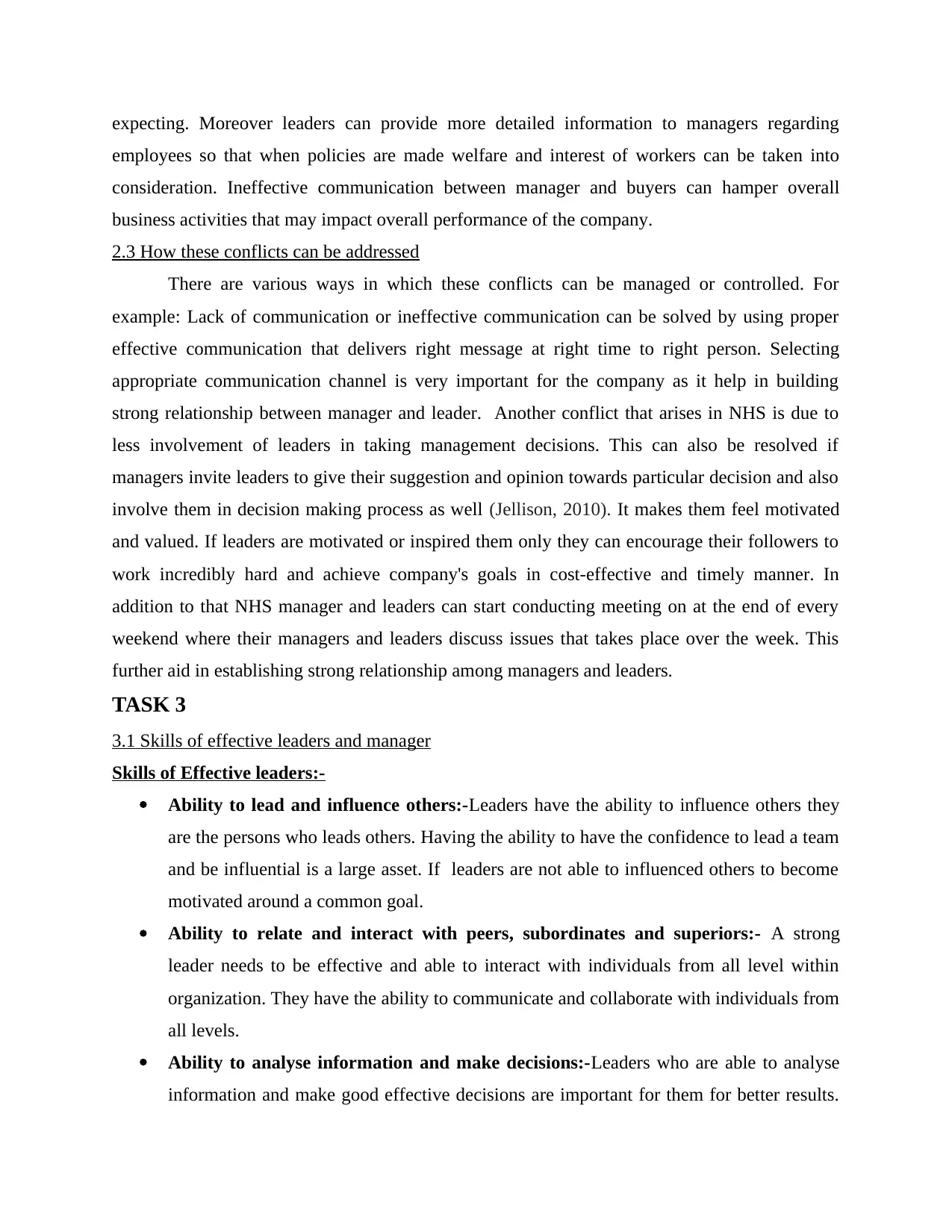
expecting. Moreover leaders can provide more detailed information to managers regarding
employees so that when policies are made welfare and interest of workers can be taken into
consideration. Ineffective communication between manager and buyers can hamper overall
business activities that may impact overall performance of the company.
2.3 How these conflicts can be addressed
There are various ways in which these conflicts can be managed or controlled. For
example: Lack of communication or ineffective communication can be solved by using proper
effective communication that delivers right message at right time to right person. Selecting
appropriate communication channel is very important for the company as it help in building
strong relationship between manager and leader. Another conflict that arises in NHS is due to
less involvement of leaders in taking management decisions. This can also be resolved if
managers invite leaders to give their suggestion and opinion towards particular decision and also
involve them in decision making process as well (Jellison, 2010). It makes them feel motivated
and valued. If leaders are motivated or inspired them only they can encourage their followers to
work incredibly hard and achieve company's goals in cost-effective and timely manner. In
addition to that NHS manager and leaders can start conducting meeting on at the end of every
weekend where their managers and leaders discuss issues that takes place over the week. This
further aid in establishing strong relationship among managers and leaders.
TASK 3
3.1 Skills of effective leaders and manager
Skills of Effective leaders:-
Ability to lead and influence others:-Leaders have the ability to influence others they
are the persons who leads others. Having the ability to have the confidence to lead a team
and be influential is a large asset. If leaders are not able to influenced others to become
motivated around a common goal.
Ability to relate and interact with peers, subordinates and superiors:- A strong
leader needs to be effective and able to interact with individuals from all level within
organization. They have the ability to communicate and collaborate with individuals from
all levels.
Ability to analyse information and make decisions:-Leaders who are able to analyse
information and make good effective decisions are important for them for better results.
employees so that when policies are made welfare and interest of workers can be taken into
consideration. Ineffective communication between manager and buyers can hamper overall
business activities that may impact overall performance of the company.
2.3 How these conflicts can be addressed
There are various ways in which these conflicts can be managed or controlled. For
example: Lack of communication or ineffective communication can be solved by using proper
effective communication that delivers right message at right time to right person. Selecting
appropriate communication channel is very important for the company as it help in building
strong relationship between manager and leader. Another conflict that arises in NHS is due to
less involvement of leaders in taking management decisions. This can also be resolved if
managers invite leaders to give their suggestion and opinion towards particular decision and also
involve them in decision making process as well (Jellison, 2010). It makes them feel motivated
and valued. If leaders are motivated or inspired them only they can encourage their followers to
work incredibly hard and achieve company's goals in cost-effective and timely manner. In
addition to that NHS manager and leaders can start conducting meeting on at the end of every
weekend where their managers and leaders discuss issues that takes place over the week. This
further aid in establishing strong relationship among managers and leaders.
TASK 3
3.1 Skills of effective leaders and manager
Skills of Effective leaders:-
Ability to lead and influence others:-Leaders have the ability to influence others they
are the persons who leads others. Having the ability to have the confidence to lead a team
and be influential is a large asset. If leaders are not able to influenced others to become
motivated around a common goal.
Ability to relate and interact with peers, subordinates and superiors:- A strong
leader needs to be effective and able to interact with individuals from all level within
organization. They have the ability to communicate and collaborate with individuals from
all levels.
Ability to analyse information and make decisions:-Leaders who are able to analyse
information and make good effective decisions are important for them for better results.
Paraphrase This Document
Need a fresh take? Get an instant paraphrase of this document with our AI Paraphraser
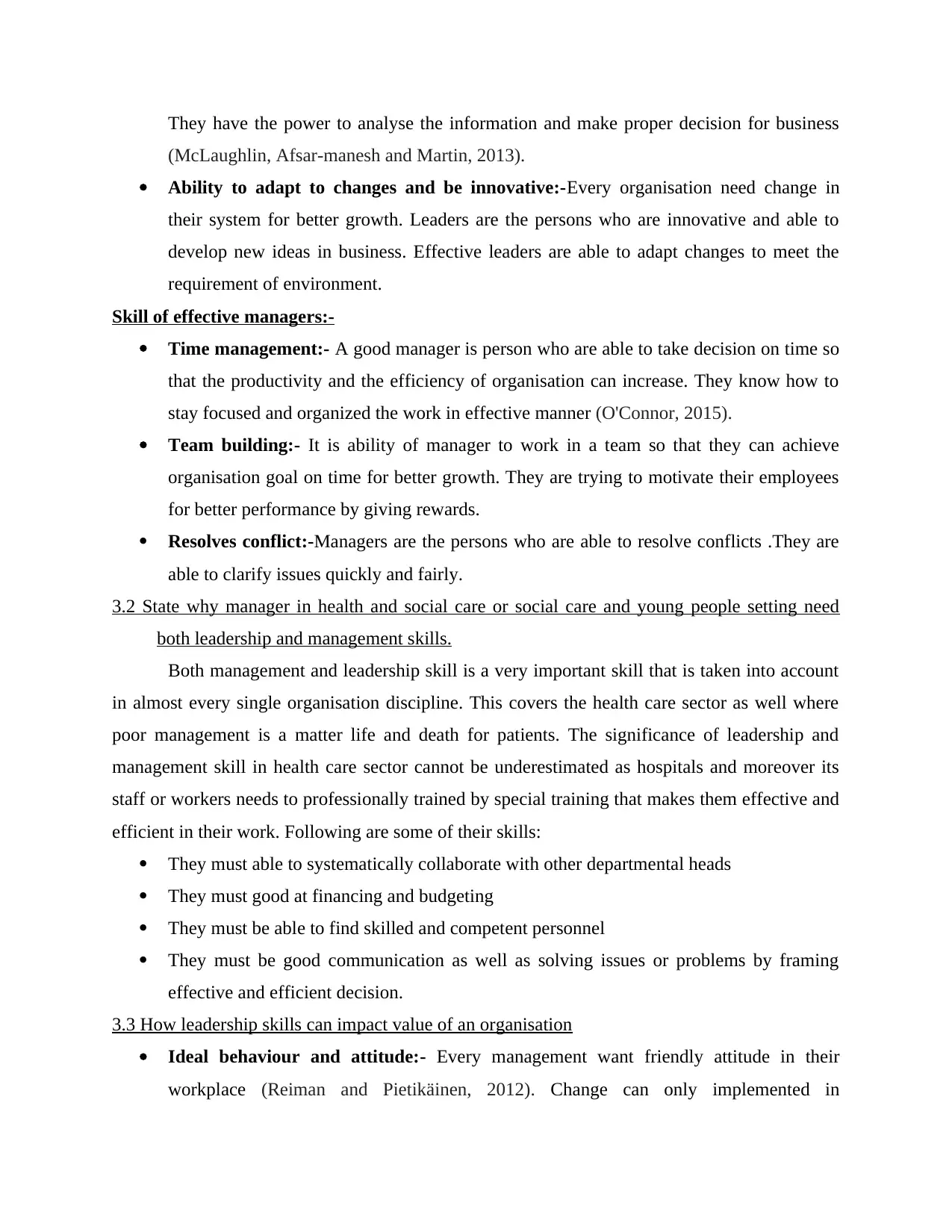
They have the power to analyse the information and make proper decision for business
(McLaughlin, Afsar-manesh and Martin, 2013).
Ability to adapt to changes and be innovative:-Every organisation need change in
their system for better growth. Leaders are the persons who are innovative and able to
develop new ideas in business. Effective leaders are able to adapt changes to meet the
requirement of environment.
Skill of effective managers:-
Time management:- A good manager is person who are able to take decision on time so
that the productivity and the efficiency of organisation can increase. They know how to
stay focused and organized the work in effective manner (O'Connor, 2015).
Team building:- It is ability of manager to work in a team so that they can achieve
organisation goal on time for better growth. They are trying to motivate their employees
for better performance by giving rewards.
Resolves conflict:-Managers are the persons who are able to resolve conflicts .They are
able to clarify issues quickly and fairly.
3.2 State why manager in health and social care or social care and young people setting need
both leadership and management skills.
Both management and leadership skill is a very important skill that is taken into account
in almost every single organisation discipline. This covers the health care sector as well where
poor management is a matter life and death for patients. The significance of leadership and
management skill in health care sector cannot be underestimated as hospitals and moreover its
staff or workers needs to professionally trained by special training that makes them effective and
efficient in their work. Following are some of their skills:
They must able to systematically collaborate with other departmental heads
They must good at financing and budgeting
They must be able to find skilled and competent personnel
They must be good communication as well as solving issues or problems by framing
effective and efficient decision.
3.3 How leadership skills can impact value of an organisation
Ideal behaviour and attitude:- Every management want friendly attitude in their
workplace (Reiman and Pietikäinen, 2012). Change can only implemented in
(McLaughlin, Afsar-manesh and Martin, 2013).
Ability to adapt to changes and be innovative:-Every organisation need change in
their system for better growth. Leaders are the persons who are innovative and able to
develop new ideas in business. Effective leaders are able to adapt changes to meet the
requirement of environment.
Skill of effective managers:-
Time management:- A good manager is person who are able to take decision on time so
that the productivity and the efficiency of organisation can increase. They know how to
stay focused and organized the work in effective manner (O'Connor, 2015).
Team building:- It is ability of manager to work in a team so that they can achieve
organisation goal on time for better growth. They are trying to motivate their employees
for better performance by giving rewards.
Resolves conflict:-Managers are the persons who are able to resolve conflicts .They are
able to clarify issues quickly and fairly.
3.2 State why manager in health and social care or social care and young people setting need
both leadership and management skills.
Both management and leadership skill is a very important skill that is taken into account
in almost every single organisation discipline. This covers the health care sector as well where
poor management is a matter life and death for patients. The significance of leadership and
management skill in health care sector cannot be underestimated as hospitals and moreover its
staff or workers needs to professionally trained by special training that makes them effective and
efficient in their work. Following are some of their skills:
They must able to systematically collaborate with other departmental heads
They must good at financing and budgeting
They must be able to find skilled and competent personnel
They must be good communication as well as solving issues or problems by framing
effective and efficient decision.
3.3 How leadership skills can impact value of an organisation
Ideal behaviour and attitude:- Every management want friendly attitude in their
workplace (Reiman and Pietikäinen, 2012). Change can only implemented in
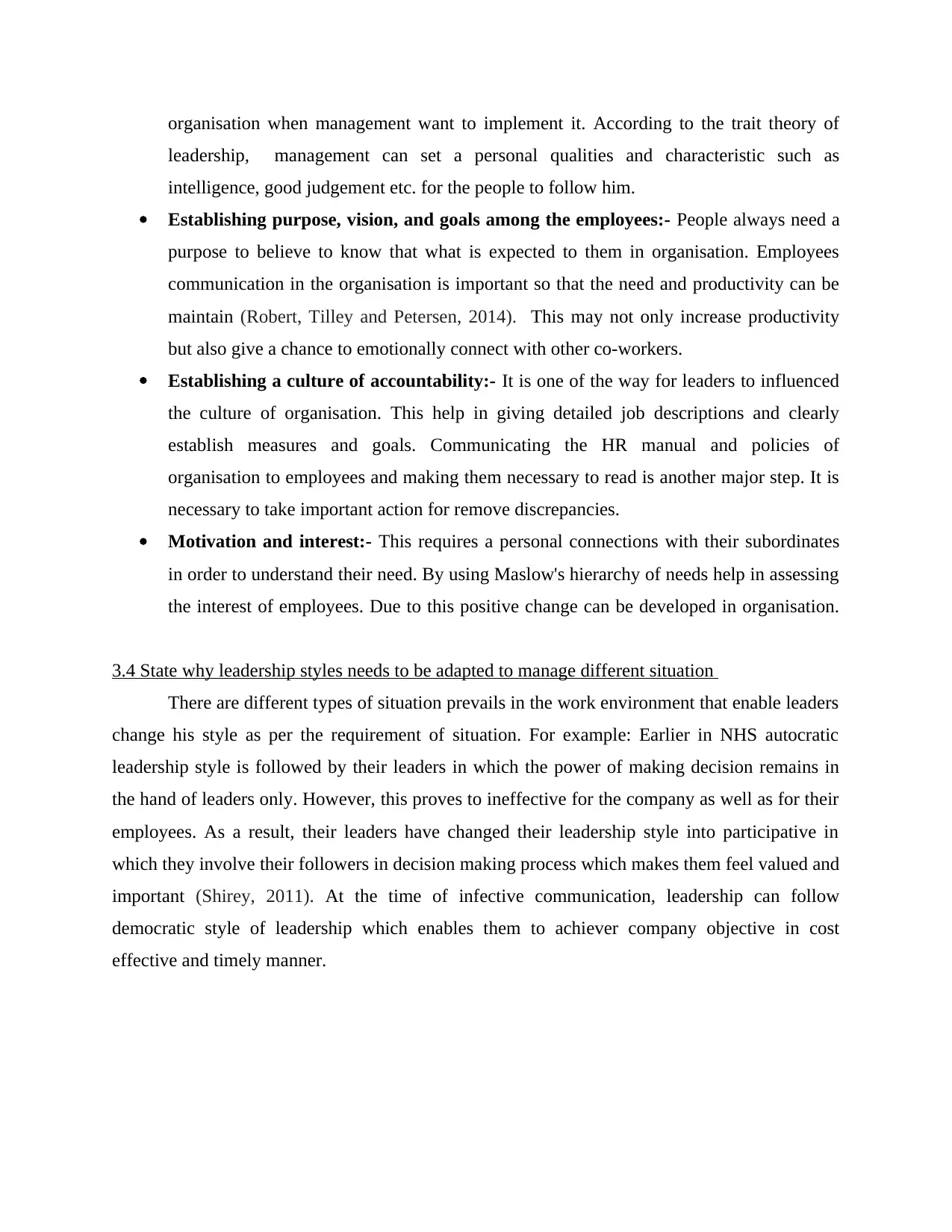
organisation when management want to implement it. According to the trait theory of
leadership, management can set a personal qualities and characteristic such as
intelligence, good judgement etc. for the people to follow him.
Establishing purpose, vision, and goals among the employees:- People always need a
purpose to believe to know that what is expected to them in organisation. Employees
communication in the organisation is important so that the need and productivity can be
maintain (Robert, Tilley and Petersen, 2014). This may not only increase productivity
but also give a chance to emotionally connect with other co-workers.
Establishing a culture of accountability:- It is one of the way for leaders to influenced
the culture of organisation. This help in giving detailed job descriptions and clearly
establish measures and goals. Communicating the HR manual and policies of
organisation to employees and making them necessary to read is another major step. It is
necessary to take important action for remove discrepancies.
Motivation and interest:- This requires a personal connections with their subordinates
in order to understand their need. By using Maslow's hierarchy of needs help in assessing
the interest of employees. Due to this positive change can be developed in organisation.
3.4 State why leadership styles needs to be adapted to manage different situation
There are different types of situation prevails in the work environment that enable leaders
change his style as per the requirement of situation. For example: Earlier in NHS autocratic
leadership style is followed by their leaders in which the power of making decision remains in
the hand of leaders only. However, this proves to ineffective for the company as well as for their
employees. As a result, their leaders have changed their leadership style into participative in
which they involve their followers in decision making process which makes them feel valued and
important (Shirey, 2011). At the time of infective communication, leadership can follow
democratic style of leadership which enables them to achiever company objective in cost
effective and timely manner.
leadership, management can set a personal qualities and characteristic such as
intelligence, good judgement etc. for the people to follow him.
Establishing purpose, vision, and goals among the employees:- People always need a
purpose to believe to know that what is expected to them in organisation. Employees
communication in the organisation is important so that the need and productivity can be
maintain (Robert, Tilley and Petersen, 2014). This may not only increase productivity
but also give a chance to emotionally connect with other co-workers.
Establishing a culture of accountability:- It is one of the way for leaders to influenced
the culture of organisation. This help in giving detailed job descriptions and clearly
establish measures and goals. Communicating the HR manual and policies of
organisation to employees and making them necessary to read is another major step. It is
necessary to take important action for remove discrepancies.
Motivation and interest:- This requires a personal connections with their subordinates
in order to understand their need. By using Maslow's hierarchy of needs help in assessing
the interest of employees. Due to this positive change can be developed in organisation.
3.4 State why leadership styles needs to be adapted to manage different situation
There are different types of situation prevails in the work environment that enable leaders
change his style as per the requirement of situation. For example: Earlier in NHS autocratic
leadership style is followed by their leaders in which the power of making decision remains in
the hand of leaders only. However, this proves to ineffective for the company as well as for their
employees. As a result, their leaders have changed their leadership style into participative in
which they involve their followers in decision making process which makes them feel valued and
important (Shirey, 2011). At the time of infective communication, leadership can follow
democratic style of leadership which enables them to achiever company objective in cost
effective and timely manner.
⊘ This is a preview!⊘
Do you want full access?
Subscribe today to unlock all pages.

Trusted by 1+ million students worldwide
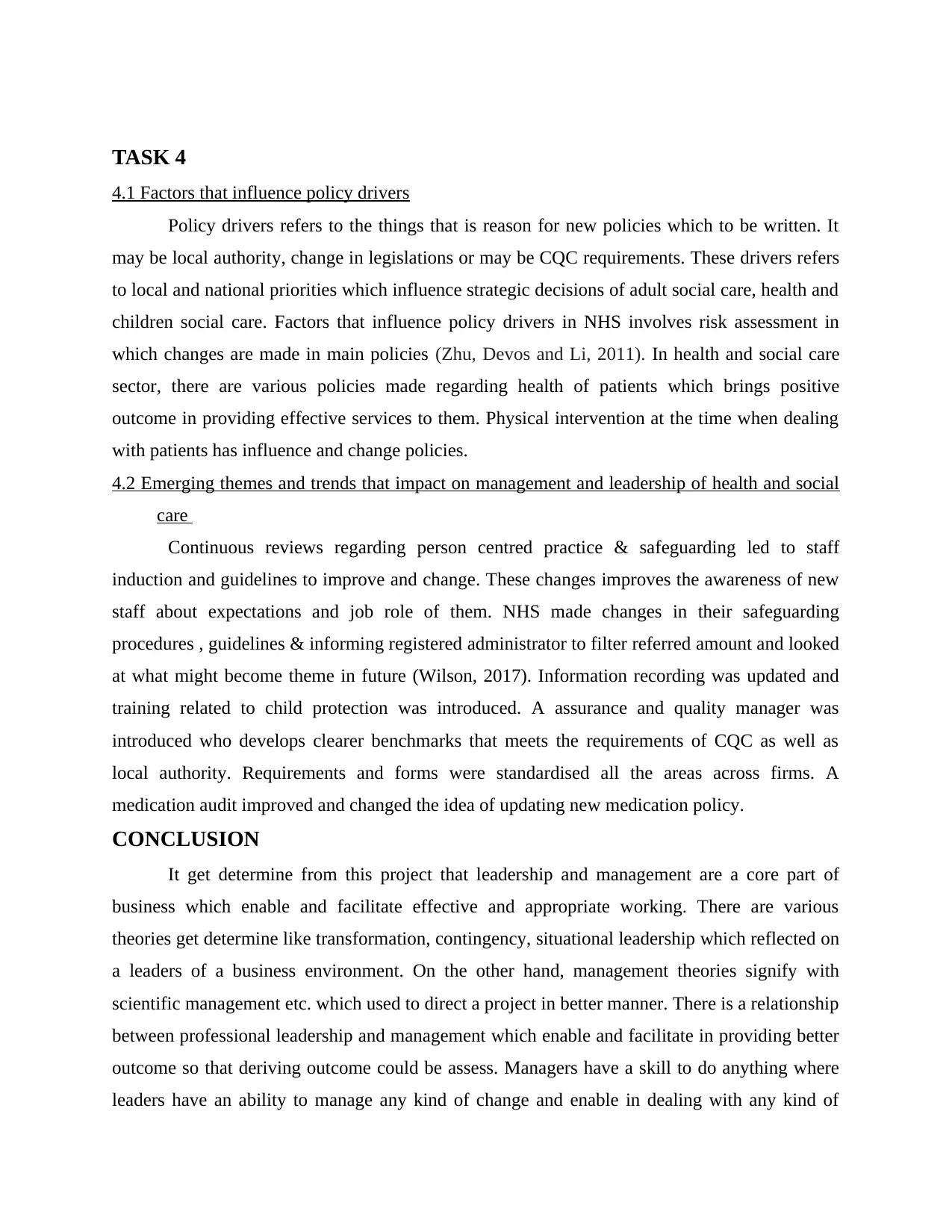
TASK 4
4.1 Factors that influence policy drivers
Policy drivers refers to the things that is reason for new policies which to be written. It
may be local authority, change in legislations or may be CQC requirements. These drivers refers
to local and national priorities which influence strategic decisions of adult social care, health and
children social care. Factors that influence policy drivers in NHS involves risk assessment in
which changes are made in main policies (Zhu, Devos and Li, 2011). In health and social care
sector, there are various policies made regarding health of patients which brings positive
outcome in providing effective services to them. Physical intervention at the time when dealing
with patients has influence and change policies.
4.2 Emerging themes and trends that impact on management and leadership of health and social
care
Continuous reviews regarding person centred practice & safeguarding led to staff
induction and guidelines to improve and change. These changes improves the awareness of new
staff about expectations and job role of them. NHS made changes in their safeguarding
procedures , guidelines & informing registered administrator to filter referred amount and looked
at what might become theme in future (Wilson, 2017). Information recording was updated and
training related to child protection was introduced. A assurance and quality manager was
introduced who develops clearer benchmarks that meets the requirements of CQC as well as
local authority. Requirements and forms were standardised all the areas across firms. A
medication audit improved and changed the idea of updating new medication policy.
CONCLUSION
It get determine from this project that leadership and management are a core part of
business which enable and facilitate effective and appropriate working. There are various
theories get determine like transformation, contingency, situational leadership which reflected on
a leaders of a business environment. On the other hand, management theories signify with
scientific management etc. which used to direct a project in better manner. There is a relationship
between professional leadership and management which enable and facilitate in providing better
outcome so that deriving outcome could be assess. Managers have a skill to do anything where
leaders have an ability to manage any kind of change and enable in dealing with any kind of
4.1 Factors that influence policy drivers
Policy drivers refers to the things that is reason for new policies which to be written. It
may be local authority, change in legislations or may be CQC requirements. These drivers refers
to local and national priorities which influence strategic decisions of adult social care, health and
children social care. Factors that influence policy drivers in NHS involves risk assessment in
which changes are made in main policies (Zhu, Devos and Li, 2011). In health and social care
sector, there are various policies made regarding health of patients which brings positive
outcome in providing effective services to them. Physical intervention at the time when dealing
with patients has influence and change policies.
4.2 Emerging themes and trends that impact on management and leadership of health and social
care
Continuous reviews regarding person centred practice & safeguarding led to staff
induction and guidelines to improve and change. These changes improves the awareness of new
staff about expectations and job role of them. NHS made changes in their safeguarding
procedures , guidelines & informing registered administrator to filter referred amount and looked
at what might become theme in future (Wilson, 2017). Information recording was updated and
training related to child protection was introduced. A assurance and quality manager was
introduced who develops clearer benchmarks that meets the requirements of CQC as well as
local authority. Requirements and forms were standardised all the areas across firms. A
medication audit improved and changed the idea of updating new medication policy.
CONCLUSION
It get determine from this project that leadership and management are a core part of
business which enable and facilitate effective and appropriate working. There are various
theories get determine like transformation, contingency, situational leadership which reflected on
a leaders of a business environment. On the other hand, management theories signify with
scientific management etc. which used to direct a project in better manner. There is a relationship
between professional leadership and management which enable and facilitate in providing better
outcome so that deriving outcome could be assess. Managers have a skill to do anything where
leaders have an ability to manage any kind of change and enable in dealing with any kind of
Paraphrase This Document
Need a fresh take? Get an instant paraphrase of this document with our AI Paraphraser
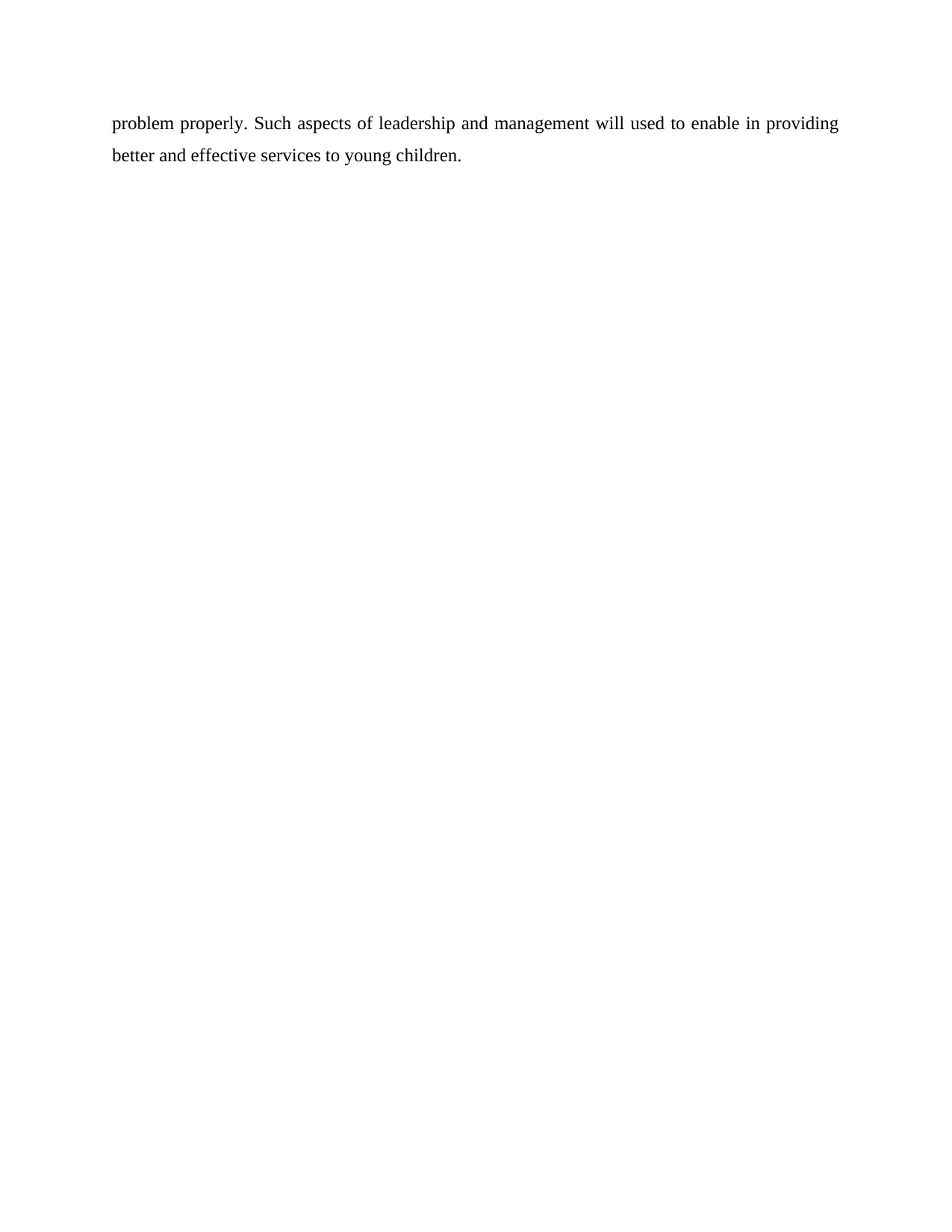
problem properly. Such aspects of leadership and management will used to enable in providing
better and effective services to young children.
better and effective services to young children.
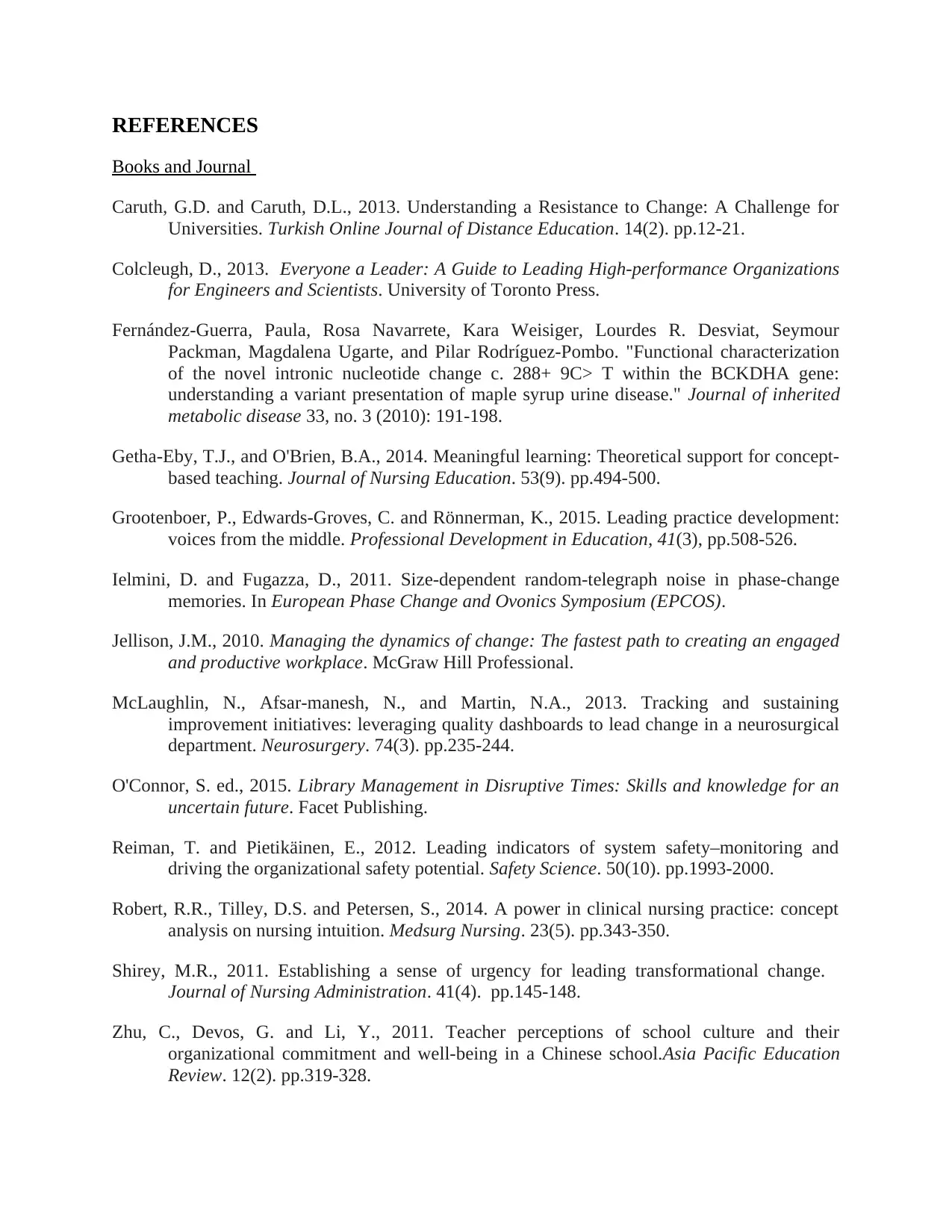
REFERENCES
Books and Journal
Caruth, G.D. and Caruth, D.L., 2013. Understanding a Resistance to Change: A Challenge for
Universities. Turkish Online Journal of Distance Education. 14(2). pp.12-21.
Colcleugh, D., 2013. Everyone a Leader: A Guide to Leading High-performance Organizations
for Engineers and Scientists. University of Toronto Press.
Fernández-Guerra, Paula, Rosa Navarrete, Kara Weisiger, Lourdes R. Desviat, Seymour
Packman, Magdalena Ugarte, and Pilar Rodríguez-Pombo. "Functional characterization
of the novel intronic nucleotide change c. 288+ 9C> T within the BCKDHA gene:
understanding a variant presentation of maple syrup urine disease." Journal of inherited
metabolic disease 33, no. 3 (2010): 191-198.
Getha-Eby, T.J., and O'Brien, B.A., 2014. Meaningful learning: Theoretical support for concept-
based teaching. Journal of Nursing Education. 53(9). pp.494-500.
Grootenboer, P., Edwards-Groves, C. and Rönnerman, K., 2015. Leading practice development:
voices from the middle. Professional Development in Education, 41(3), pp.508-526.
Ielmini, D. and Fugazza, D., 2011. Size-dependent random-telegraph noise in phase-change
memories. In European Phase Change and Ovonics Symposium (EPCOS).
Jellison, J.M., 2010. Managing the dynamics of change: The fastest path to creating an engaged
and productive workplace. McGraw Hill Professional.
McLaughlin, N., Afsar-manesh, N., and Martin, N.A., 2013. Tracking and sustaining
improvement initiatives: leveraging quality dashboards to lead change in a neurosurgical
department. Neurosurgery. 74(3). pp.235-244.
O'Connor, S. ed., 2015. Library Management in Disruptive Times: Skills and knowledge for an
uncertain future. Facet Publishing.
Reiman, T. and Pietikäinen, E., 2012. Leading indicators of system safety–monitoring and
driving the organizational safety potential. Safety Science. 50(10). pp.1993-2000.
Robert, R.R., Tilley, D.S. and Petersen, S., 2014. A power in clinical nursing practice: concept
analysis on nursing intuition. Medsurg Nursing. 23(5). pp.343-350.
Shirey, M.R., 2011. Establishing a sense of urgency for leading transformational change.
Journal of Nursing Administration. 41(4). pp.145-148.
Zhu, C., Devos, G. and Li, Y., 2011. Teacher perceptions of school culture and their
organizational commitment and well-being in a Chinese school.Asia Pacific Education
Review. 12(2). pp.319-328.
Books and Journal
Caruth, G.D. and Caruth, D.L., 2013. Understanding a Resistance to Change: A Challenge for
Universities. Turkish Online Journal of Distance Education. 14(2). pp.12-21.
Colcleugh, D., 2013. Everyone a Leader: A Guide to Leading High-performance Organizations
for Engineers and Scientists. University of Toronto Press.
Fernández-Guerra, Paula, Rosa Navarrete, Kara Weisiger, Lourdes R. Desviat, Seymour
Packman, Magdalena Ugarte, and Pilar Rodríguez-Pombo. "Functional characterization
of the novel intronic nucleotide change c. 288+ 9C> T within the BCKDHA gene:
understanding a variant presentation of maple syrup urine disease." Journal of inherited
metabolic disease 33, no. 3 (2010): 191-198.
Getha-Eby, T.J., and O'Brien, B.A., 2014. Meaningful learning: Theoretical support for concept-
based teaching. Journal of Nursing Education. 53(9). pp.494-500.
Grootenboer, P., Edwards-Groves, C. and Rönnerman, K., 2015. Leading practice development:
voices from the middle. Professional Development in Education, 41(3), pp.508-526.
Ielmini, D. and Fugazza, D., 2011. Size-dependent random-telegraph noise in phase-change
memories. In European Phase Change and Ovonics Symposium (EPCOS).
Jellison, J.M., 2010. Managing the dynamics of change: The fastest path to creating an engaged
and productive workplace. McGraw Hill Professional.
McLaughlin, N., Afsar-manesh, N., and Martin, N.A., 2013. Tracking and sustaining
improvement initiatives: leveraging quality dashboards to lead change in a neurosurgical
department. Neurosurgery. 74(3). pp.235-244.
O'Connor, S. ed., 2015. Library Management in Disruptive Times: Skills and knowledge for an
uncertain future. Facet Publishing.
Reiman, T. and Pietikäinen, E., 2012. Leading indicators of system safety–monitoring and
driving the organizational safety potential. Safety Science. 50(10). pp.1993-2000.
Robert, R.R., Tilley, D.S. and Petersen, S., 2014. A power in clinical nursing practice: concept
analysis on nursing intuition. Medsurg Nursing. 23(5). pp.343-350.
Shirey, M.R., 2011. Establishing a sense of urgency for leading transformational change.
Journal of Nursing Administration. 41(4). pp.145-148.
Zhu, C., Devos, G. and Li, Y., 2011. Teacher perceptions of school culture and their
organizational commitment and well-being in a Chinese school.Asia Pacific Education
Review. 12(2). pp.319-328.
⊘ This is a preview!⊘
Do you want full access?
Subscribe today to unlock all pages.

Trusted by 1+ million students worldwide
1 out of 13
Related Documents
Your All-in-One AI-Powered Toolkit for Academic Success.
+13062052269
info@desklib.com
Available 24*7 on WhatsApp / Email
![[object Object]](/_next/static/media/star-bottom.7253800d.svg)
Unlock your academic potential
Copyright © 2020–2025 A2Z Services. All Rights Reserved. Developed and managed by ZUCOL.





